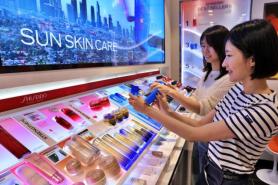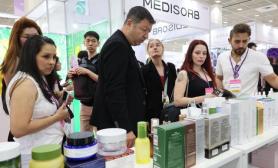
The latest data, released Monday by the Ministry of Food and Drug Safety, marks the highest first-half export total in the country’s history and reinforces South Korea’s position as the world’s third-largest cosmetics exporter, behind only France and the United States.
If current trends hold, South Korea could overtake the United States for second place by year’s end, industry experts say.
K-beauty’s rising profile reflects more than just trend-driven appeal. Once heavily reliant on the Chinese market, the industry has strategically diversified, gaining traction across North America, Europe, the Middle East, and Latin America.
Exports to China accounted for just 19.6 percent of the total in the first half of this year — down sharply from 34.7 percent in 2023 — as shipments to other regions surged.
Sales to the United States jumped 17.7 percent year over year, while Japan saw a 15.7 percent increase. Korean cosmetics now rank as the top import brand in both countries. European markets also posted robust gains: exports to Poland soared 133.8 percent to $150 million, and shipments to the United Kingdom climbed 46.2 percent to $100 million.
The Middle East and Latin America contributed to the broader momentum. Exports to the United Arab Emirates rose 69.4 percent, and shipments to Mexico leapt 138.3 percent — an indication, analysts say, of Korea’s growing ability to cater to varied consumer needs across cultural and climatic boundaries.
“South Korea is no longer exporting just a beauty trend,” said Kim Ji-eun, an analyst at Korea Trade-Investment Promotion Agency. “It’s exporting a manufacturing ecosystem — and a very sophisticated one at that.”
That ecosystem includes major original design and equipment manufacturers such as Korea Kolmar and Cosmax, which have enabled smaller brands to develop and scale custom products without sacrificing quality or speed. Combined with distribution platforms like CJ Olive Young — which handles more than 2,400 brands monthly — these players have reshaped how beauty products move from lab to shelf worldwide.
Behind the numbers lies a deeper shift in strategy.
Rather than relying solely on sleek packaging or celebrity endorsements, Korean firms are investing in functionality, affordability, and rapid product cycles. Customized formulations for diverse skin types, climate conditions, and cultural preferences are now standard.
Cosmetics exports have steadily risen from $9.2 billion in 2021 to $10.2 billion in 2024, with a brief dip in 2022 tied to Chinese economic softness. But the rebound has been swift and sustained — and, increasingly, independent of any single market.
“The global beauty industry is no longer dominated by Western giants alone,” said Park So-young, a senior researcher at the Korea Institute for Industrial Economics and Trade. “K-beauty isn’t just a wave. It’s an infrastructure — and it’s built to last.”
Copyright ⓒ Aju Press All rights reserved.


![[K-Beauty] South Koreas SME minister pledges export support amid US tariff concerns](https://image.ajunews.com/content/image/2025/08/07/20250807142516802549_278_163.jpg)

